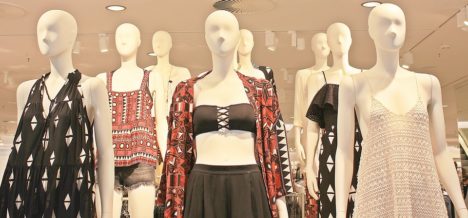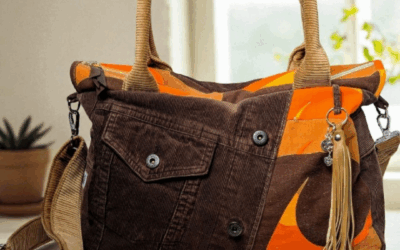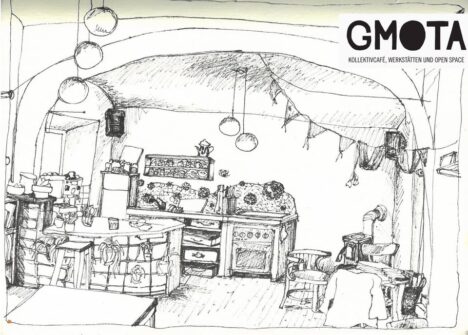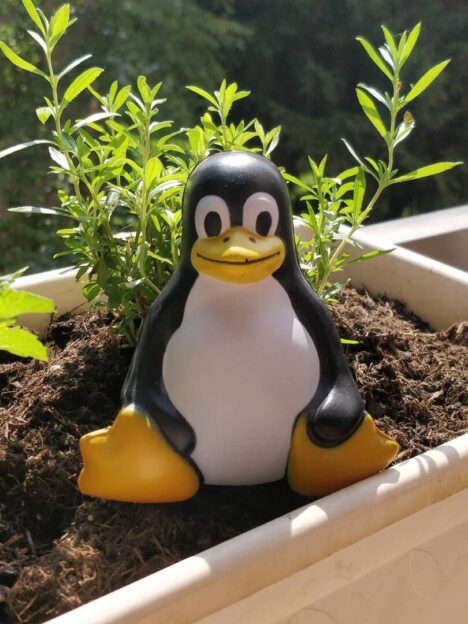Original post by Hannah on April 24, 2019: Fast Fashion. Translated by Lisa Scheer in 2023/24.
Disclaimer: Some of the links in this post might redirect you to a site in German. Feel free to use Machine Translation (such as DeepL or Google Translate) to get the information provided on these sites.
Fashion is, following the oil industry, the industry that pollutes our planet the most. Fast fashion has become a throwaway product. This has disastrous consequences for people and the environment (starting from the raw materials and continuing to you washing your clothes).
Definition
‚Fast fashion‘ first appeared in the 90s. There is no uniform definition for it. In general, it refers to big fashion companies imitating runway trends at top speeds and reproduce them as fast and as cheap as possible. Companies therefore have to react to new releases of designers in no time. Among other things, this leads to them having their collections produced in low-wage countries to save a lot of money. A big company such as „Zara“ can create a whole collection starting at designs going to finished products in only two months. Moreover, there is a big competition between different companies, which leads them to produce and advertise even more quickly and cheaply.
History

Even if it looks like it these days, this behaviour of the fashion industry is not a new problem. During colonisation rich countries started to exploit the people in colonised countries through slavery. Child labour was also a solution to harvest cotton even quicker and cheaper. Then the cotton was transported to England where it was further processed. Thanks to the industrial revolution it was suddenly possible to process raw materials into thin threads more efficiently in English cities such as Liverpool. These fibres were then exported to Asia, China and Africa, to make clothing out of them. This development led to the textile and fashion industry being the first industry to produce mass products and selling these products cheaply. As a lot of things happened concerning politics and society in Europe, it became more expensive to produce there. This is why certain work steps within the textile industry were outsourced to Asia in the 1970s. Our clothes have been produced under extremely miserable conditions for a very long time.
We know by now that exploitation, slavery and child labour are inhumane. Still, we support these conditions by shopping at big fashion companies.
Costs
But why do most of us almost automatically buy these products? The cost is the most evident factor. Everyone can afford a T-shirt for €3.99 without putting much thought into it. We can also continuously buy new clothing pieces and be fashionable all the time. The everchanging collections are always the newest runway trends. Famous people, who are some kind of role models for us, also wear them. By producing this kind of fashion and due to our consumption big companies make huge profits. By production being incredibly cheap, they barely have any expenses and through people’s consumption habits they have incredibly high revenues. Another advantage for them is their flexibility. They can respond to demands really quickly and without issue and meet them.
Everything sounds great, doesn’t it? Everyone can shop wherever they want to for cheap and the companies make a lot of money. That’s fair, isn’t it?
Working conditions
Not at all. The circumstances in which these clothing pieces are produced are horrible. Seamstresses in Bangladesh, Sri Lanka and India barely make any money, even though they work more than twelve hours daily without any breaks. They work under inhumane, dangerous conditions and do not have any rights (Key Words Rana Plaza/Bangladesh: On April 24, 2013, a building collapsed in Rana Plaza. Thousands of seamstresses were inside. 1,138 people died and around 2,500 people were gravely injured. They had talked about the bad condition of the building but were still forced to go inside.) And also, the farmers that cultivate and harvest cotton are not off any better.
Impacts on the environment
Because of poisonous chemicals which are used in the cotton industry, a lot of farmers suffer from severe health conditions. Only a small percentage of cotton is sourced organically. Water consumption: Cotton fields have to be artificially and intensively watered for the biggest part. This leads to tragic ecological but also social consequences: the Aral Sea, which used to be the fourth largest inland water on our planet, has shrunk to a third of its size. What remains are salt flats.
Even in the consequent steps of raw material processing, very poisonous substances are used. These are used to cheaply tan leather, to dye clothes or to give denim the proper wash. Like this all these unhealthy and even life-threatening substances get into our waste water and not only destroy the environment but also threaten the health of humans and animals that live in these industrial zones. Some farmers and workers in textile factories therefore suffer from grave health issues. This way of manufacturing clothing leaves traces behind in villages, in countless people and in agriculture.
The transportation of cotton, fabrics and finished clothing pieces all over the world creates extremely high CO2-emissions.
The environment continues to suffer after the production of these cheaply produced clothes. Because there is cheap polyester in a lot of clothing pieces, microfibers escape from the fabric during washing and get into our wastewater. These small fibres are problematic because they are microplastic that cannot be filtered in sewage treatment plants. They also are not biologically degradable and can get back to us through the food chain.
Bad quality
By quickly producing clothes, quality is not as important. This leads to clothing pieces only having very short lifetimes, them getting unattractive relatively quickly and getting out of the consumer’s wardrobe again (or they just remain there, unworn). But what happens to them then? Unfortunately, only few people actually try to repair their clothes, because it is cheaper to just buy something new. This creates a lot of textile waste which is difficult to deal with. Recycling clothes has become a more common solution for this. H&M, for example, lets old fabric be transformed into new fibres in India. Unfortunately, this process is not done frequently but because of demands within society, big fashion companies are aiming for greener solutions. How sincere these solutions are and if they are just greenwashing, is not really transparent. At least the awareness is growing.
Slow/Fair fashion instead of fast fashion
It is time to take responsibility and slow down fast fashion again. Slow fashion:
- Wear clothes for longer: appreciating and caring for your clothes, repairing smaller and bigger damages.
- Second-hand: clothing exchange parties, second-hand stores, gift stores, friends…
- Have and buy less but instead higher quality clothes; choose basics that you can combine more easily and that are timeless, look at your wardrobe often and declutter it
- Put value in fair fashion, the upkeep of worker rights and (stricter) policies on environmental protection during the whole production chain.
To conclude
The simplest and cheapest solution for all of us would be buying our clothes second-hand, to visit flea markets or to take part in clothing exchanges. For those, who do not quite want to wear clothes from other people (yet), there are some alternatives. There are always small businesses that place importance on more environmentally friendly, fair and local production. Some examples in Graz are: Zerum, BrainyClothes, Apflbutzn, Ompura, brands such as Armedangels can also be found at Kastner and Öhler and more…
Tips:
Don’t stress out over switching to new habits. Small steps, such as consuming less fashion or shopping more consciously for durable products are great starts!
Be proud about having a piece of clothing for a long time, be proud to wear second-hand clothing. Become a role model. A movie recommendation: Everyone who is interested in this subject should watch the documentary „The True Cost„.
Interesting Links:
- Movie review: The true cost
- Short film: Das Ende unserer Kleidung
- Zero Waste Graz – Stammtisch: Nachhaltige Kleidung
- Faire Mode in Graz: Faire Mode
- App: Fair Fashion-App
- Vorteile des Second Hand
- Find further links here: https://www.dariadaria.com/fashion
Sources:
- https://www.macmillandictionary.com/buzzword/entries/fast-fashion.html
- https://www.biorama.eu/wann-wurde-unsere-mode-eigentlich-unfair/
- http://www.oeko-fair.de/index.php/cat/798/title/Wasserverbrauch
- https://www.welt.de/wirtschaft/article125663716/Bangladesch-ist-zur-Naeherin-der-Welt-geworden.html
Anmerkung der NiG-Redaktion:
Falls du keine wichtigen Beiträge oder Termine von uns verpassen willst, abonnier doch bitte gerne unseren Newsletter! Er kommt unregelmäßig und nicht zu häufig – versprochen. Oder schau regelmäßig in unseren Veranstaltungskalender.
Wenn dir gefällt, was wir auf dieser Plattform tun, nämlich bereits seit 2017 über Nachhaltigkeit, Umwelt- und Klimaschutz zu informieren, dann unterstütz uns doch bitte auch finanziell, um unsere Website in dieser Qualität und Fülle weiterführen zu können – uns hilft jeder Beitrag!
Verein „Nachhaltig in Graz“
BIC: STSPAT2GXXX
IBAN: AT20 2081 5000 4200 1552
Verwendungszweck: Spende/Sponsoring (Mehr zum Sponsoring hier)
Du kannst dir auch gerne unsere kostenlose App aufs Handy laden, damit kannst du Informationen, Veranstaltungen und vieles mehr entdecken: App Nachhaltig in Graz













